Abstract
We have demonstrated the formation of hybrid insulin/insulin-like growth factor-I(IGF-I) receptors in transfected rodent fibroblasts, which overexpress human receptors, by examining reactivity with species- and receptor-specific monoclonal antibodies. In NIH 3T3 and Rat 1 fibroblasts, endogenous IGF-I receptors were unreactive with anti-(human insulin receptor)monoclonal antibodies (47-9, 25-49, 83-14, 83-7, 18-44). However, in transfected cells expressing high levels of insulin receptors, 60-80% of high-affinity IGF-I receptors reacted with these antibodies, as assessed either by inhibition of ligand binding in intact cells or by precipitation of solubilized receptors. Conversely, endogenous insulin receptors in NIH 3T3 cells were unreactive with anti-(IGF-I receptor) antibodies alpha IR-3 and 16-13. However, approx. 50% of high-affinity insulin receptors reacted with these antibodies in cells expressing high levels of human IGF-I receptors. The hybrid receptors in transfected cells bound insulin or IGF-I with high affinity. However, responses to these ligands were asymmetrical, in that binding of IGF-I inhibited subsequent binding of insulin, but prior binding of insulin did not affect the affinity for IGF-I. The existence of hybrid receptors in normal tissues could have important implications for metabolic regulation by insulin and IGF-I.
Full text
PDF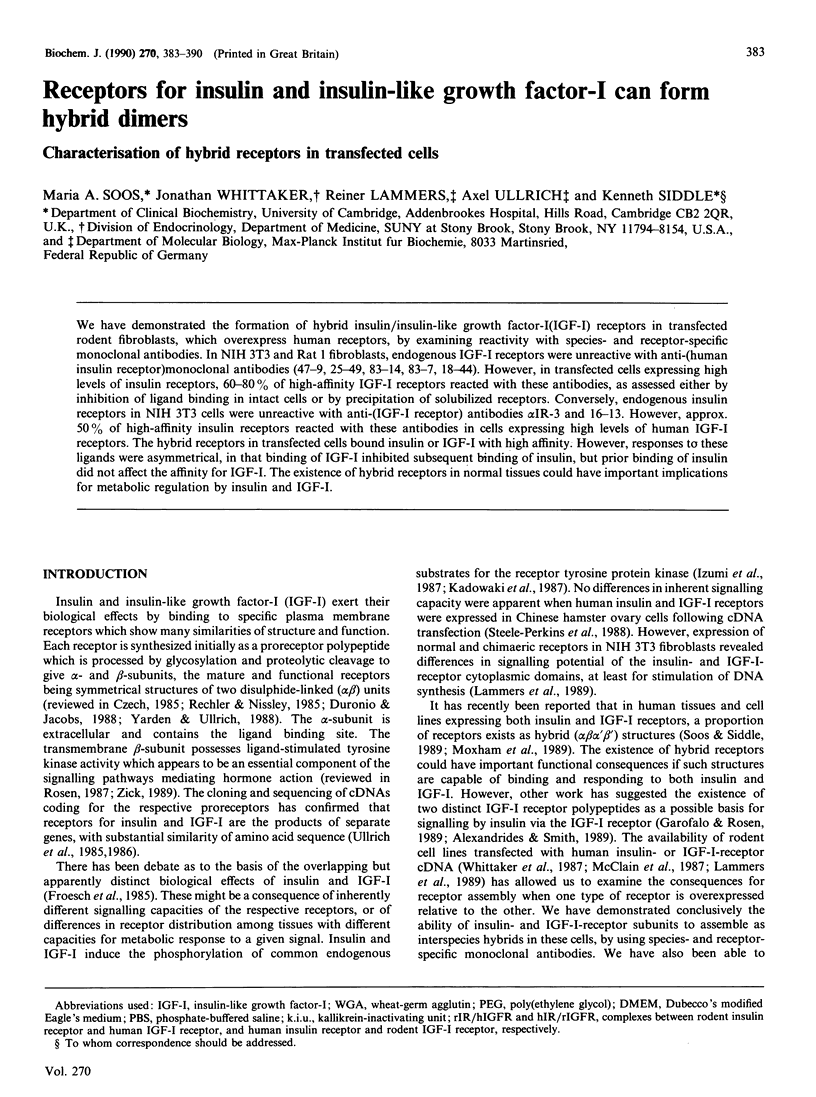
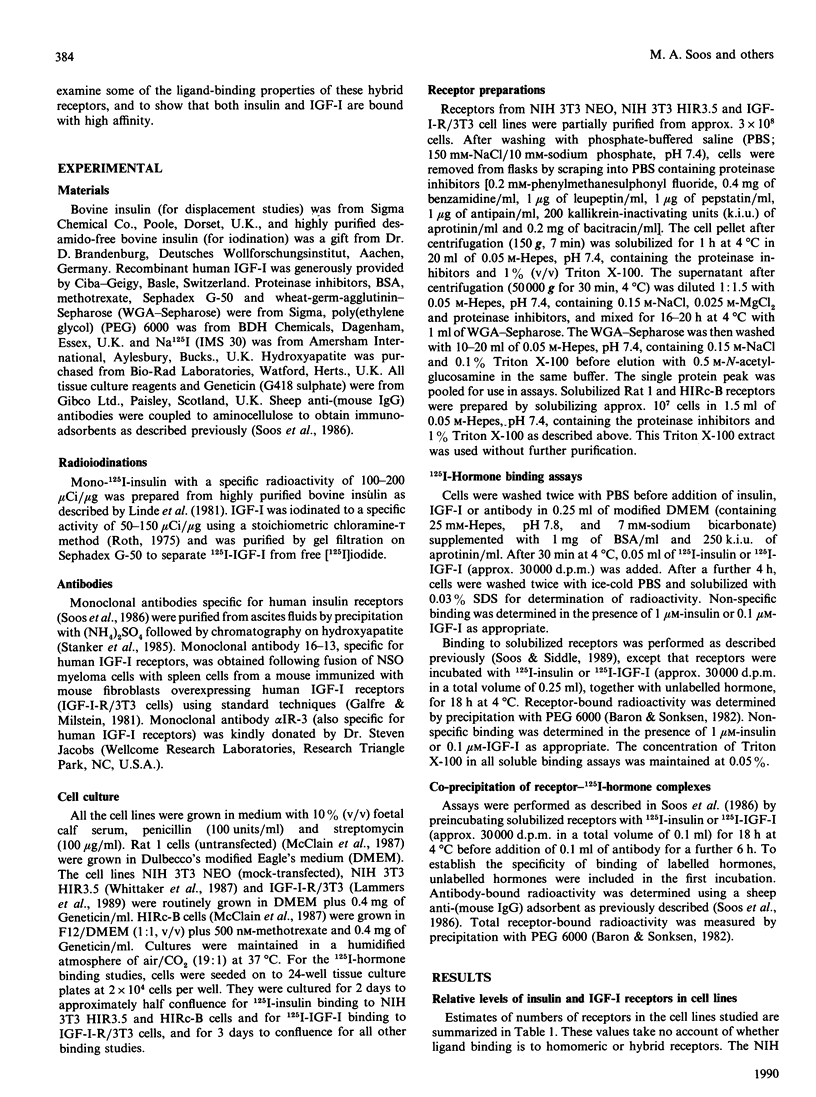
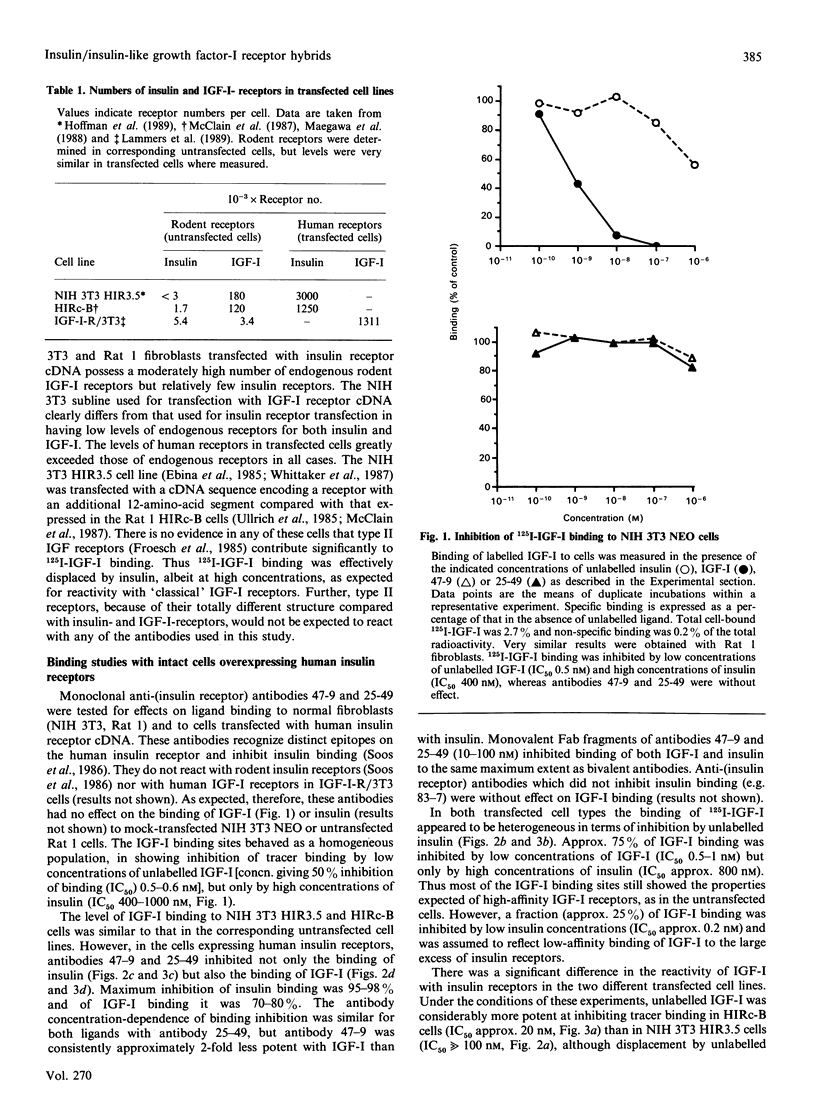
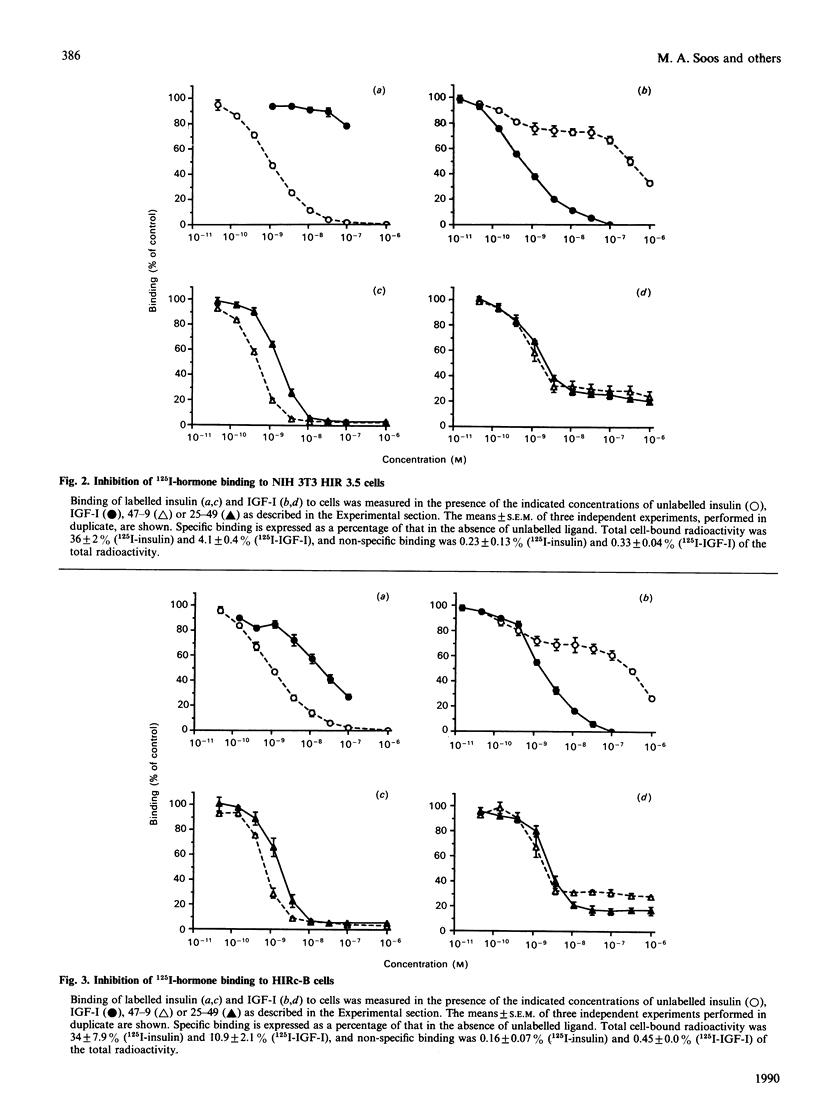
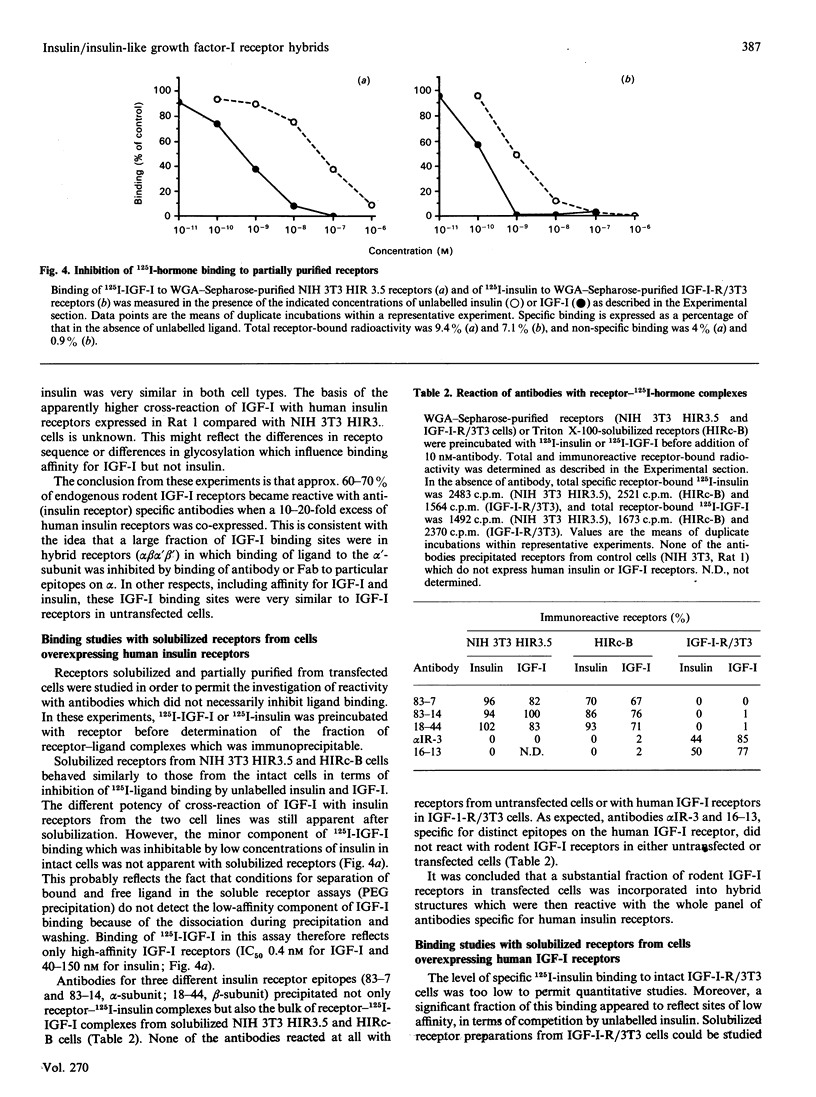
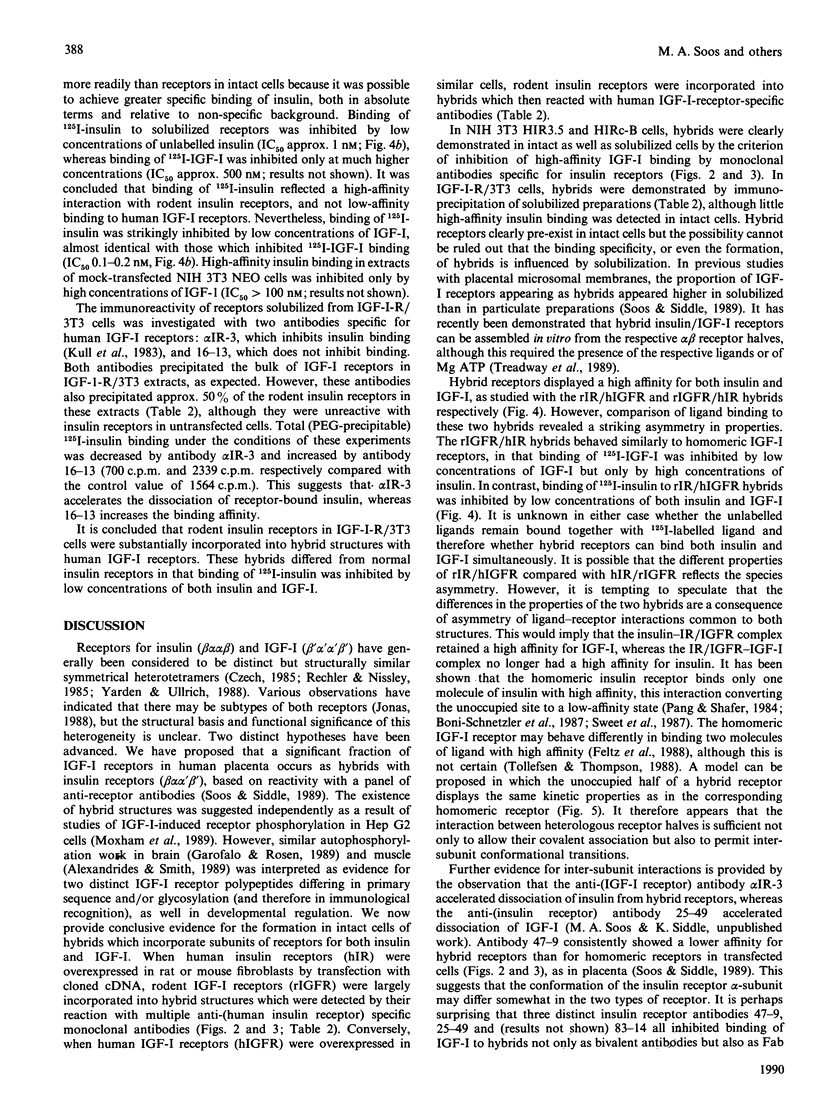
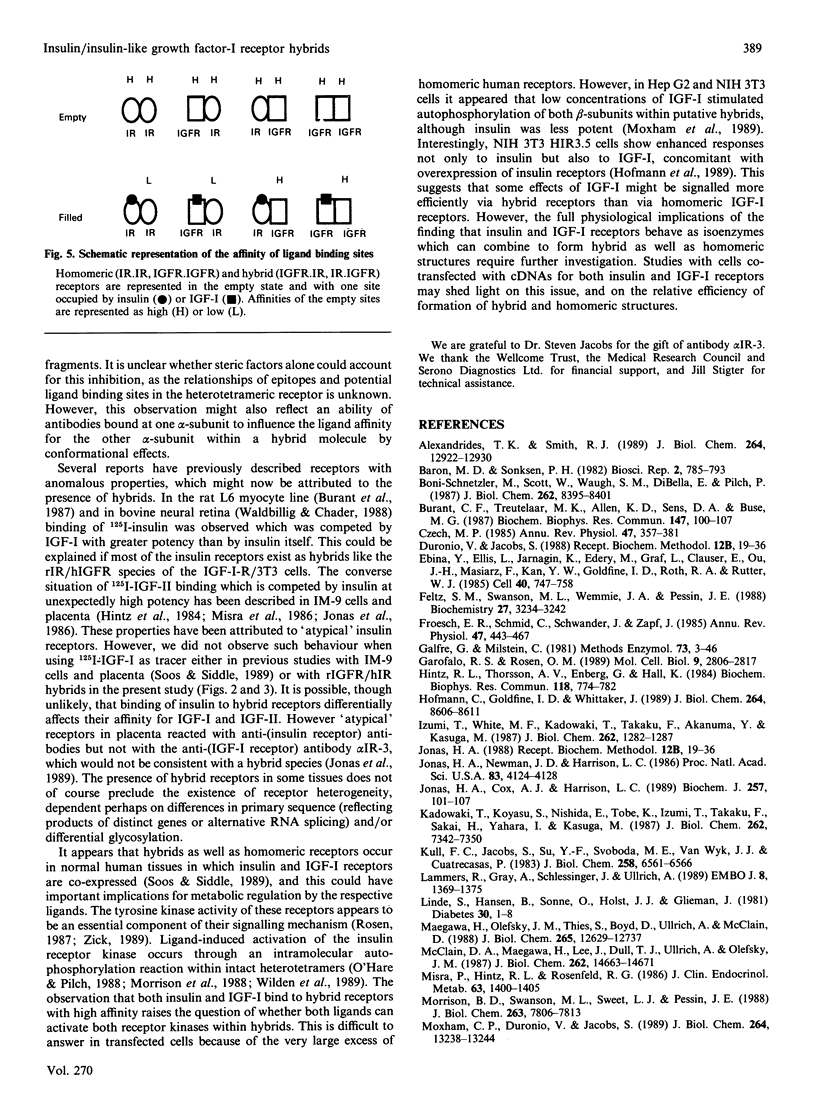
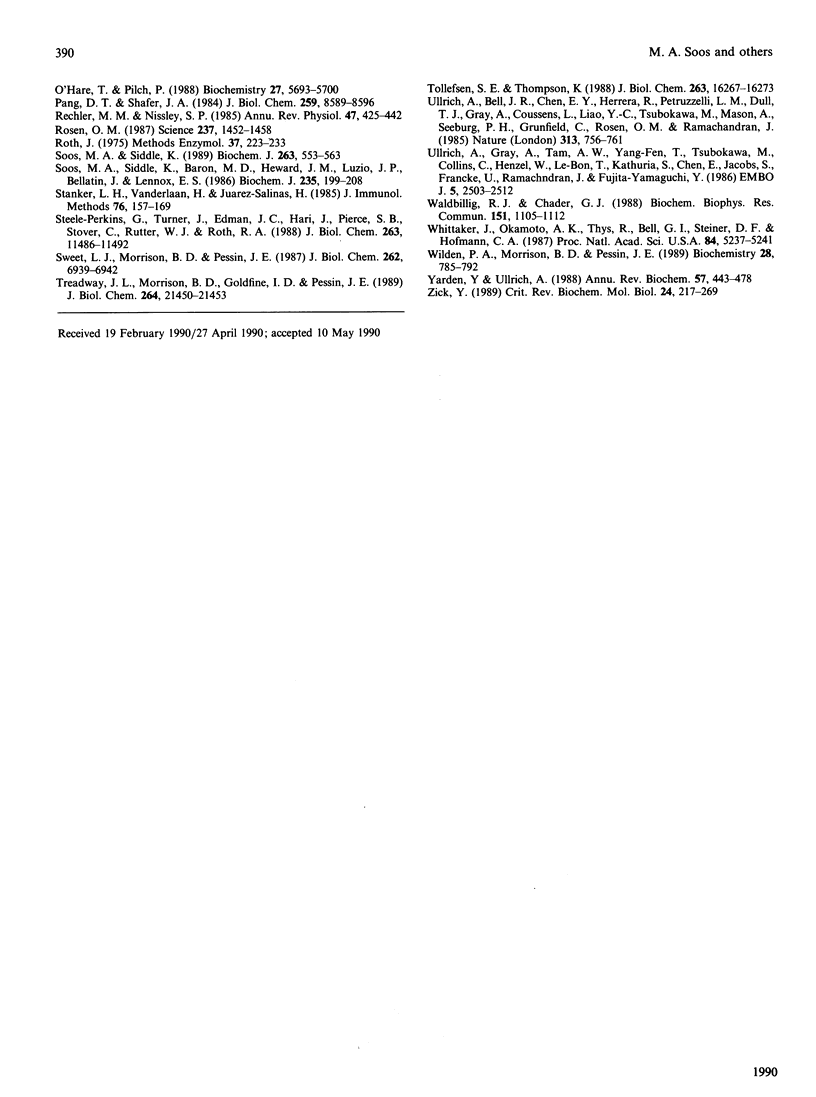
Selected References
These references are in PubMed. This may not be the complete list of references from this article.
- Alexandrides T. K., Smith R. J. A novel fetal insulin-like growth factor (IGF) I receptor. Mechanism for increased IGF I- and insulin-stimulated tyrosine kinase activity in fetal muscle. J Biol Chem. 1989 Aug 5;264(22):12922–12930. [PubMed] [Google Scholar]
- Baron M. D., Sönksen P. H. Characterization of two insulin-binding components of rat-liver plasma membranes. Biosci Rep. 1982 Oct;2(10):785–793. doi: 10.1007/BF01114938. [DOI] [PubMed] [Google Scholar]
- Burant C. F., Treutelaar M. K., Allen K. D., Sens D. A., Buse M. G. Comparison of insulin and insulin-like growth factor I receptors from rat skeletal muscle and L-6 myocytes. Biochem Biophys Res Commun. 1987 Aug 31;147(1):100–107. doi: 10.1016/s0006-291x(87)80092-x. [DOI] [PubMed] [Google Scholar]
- Böni-Schnetzler M., Scott W., Waugh S. M., DiBella E., Pilch P. F. The insulin receptor. Structural basis for high affinity ligand binding. J Biol Chem. 1987 Jun 15;262(17):8395–8401. [PubMed] [Google Scholar]
- Czech M. P. The nature and regulation of the insulin receptor: structure and function. Annu Rev Physiol. 1985;47:357–381. doi: 10.1146/annurev.ph.47.030185.002041. [DOI] [PubMed] [Google Scholar]
- Ebina Y., Ellis L., Jarnagin K., Edery M., Graf L., Clauser E., Ou J. H., Masiarz F., Kan Y. W., Goldfine I. D. The human insulin receptor cDNA: the structural basis for hormone-activated transmembrane signalling. Cell. 1985 Apr;40(4):747–758. doi: 10.1016/0092-8674(85)90334-4. [DOI] [PubMed] [Google Scholar]
- Feltz S. M., Swanson M. L., Wemmie J. A., Pessin J. E. Functional properties of an isolated alpha beta heterodimeric human placenta insulin-like growth factor 1 receptor complex. Biochemistry. 1988 May 3;27(9):3234–3242. doi: 10.1021/bi00409a017. [DOI] [PubMed] [Google Scholar]
- Froesch E. R., Schmid C., Schwander J., Zapf J. Actions of insulin-like growth factors. Annu Rev Physiol. 1985;47:443–467. doi: 10.1146/annurev.ph.47.030185.002303. [DOI] [PubMed] [Google Scholar]
- Galfrè G., Milstein C. Preparation of monoclonal antibodies: strategies and procedures. Methods Enzymol. 1981;73(Pt B):3–46. doi: 10.1016/0076-6879(81)73054-4. [DOI] [PubMed] [Google Scholar]
- Garofalo R. S., Rosen O. M. Insulin and insulinlike growth factor 1 (IGF-1) receptors during central nervous system development: expression of two immunologically distinct IGF-1 receptor beta subunits. Mol Cell Biol. 1989 Jul;9(7):2806–2817. doi: 10.1128/mcb.9.7.2806. [DOI] [PMC free article] [PubMed] [Google Scholar]
- Hintz R. L., Thorsson A. V., Enberg G., Hall K. IGF-II binding on human lymphoid cells: demonstration of a common high affinity receptor for insulin like peptides. Biochem Biophys Res Commun. 1984 Feb 14;118(3):774–782. doi: 10.1016/0006-291x(84)91462-1. [DOI] [PubMed] [Google Scholar]
- Hofmann C., Goldfine I. D., Whittaker J. The metabolic and mitogenic effects of both insulin and insulin-like growth factor are enhanced by transfection of insulin receptors into NIH3T3 fibroblasts. J Biol Chem. 1989 May 25;264(15):8606–8611. [PubMed] [Google Scholar]
- Izumi T., White M. F., Kadowaki T., Takaku F., Akanuma Y., Kasuga M. Insulin-like growth factor I rapidly stimulates tyrosine phosphorylation of a Mr 185,000 protein in intact cells. J Biol Chem. 1987 Jan 25;262(3):1282–1287. [PubMed] [Google Scholar]
- Jonas H. A., Cox A. J., Harrison L. C. Delineation of atypical insulin receptors from classical insulin and type I insulin-like growth factor receptors in human placenta. Biochem J. 1989 Jan 1;257(1):101–107. doi: 10.1042/bj2570101. [DOI] [PMC free article] [PubMed] [Google Scholar]
- Jonas H. A., Newman J. D., Harrison L. C. An atypical insulin receptor with high affinity for insulin-like growth factors copurified with placental insulin receptors. Proc Natl Acad Sci U S A. 1986 Jun;83(12):4124–4128. doi: 10.1073/pnas.83.12.4124. [DOI] [PMC free article] [PubMed] [Google Scholar]
- Kadowaki T., Koyasu S., Nishida E., Tobe K., Izumi T., Takaku F., Sakai H., Yahara I., Kasuga M. Tyrosine phosphorylation of common and specific sets of cellular proteins rapidly induced by insulin, insulin-like growth factor I, and epidermal growth factor in an intact cell. J Biol Chem. 1987 May 25;262(15):7342–7350. [PubMed] [Google Scholar]
- Kull F. C., Jr, Jacobs S., Su Y. F., Svoboda M. E., Van Wyk J. J., Cuatrecasas P. Monoclonal antibodies to receptors for insulin and somatomedin-C. J Biol Chem. 1983 May 25;258(10):6561–6566. [PubMed] [Google Scholar]
- Lammers R., Gray A., Schlessinger J., Ullrich A. Differential signalling potential of insulin- and IGF-1-receptor cytoplasmic domains. EMBO J. 1989 May;8(5):1369–1375. doi: 10.1002/j.1460-2075.1989.tb03517.x. [DOI] [PMC free article] [PubMed] [Google Scholar]
- Linde S., Hansen B., Sonne O., Holst J. J., Gliemann J. Tyrosine A14[125I]monoiodoinsulin: Preparation, Biologic Properties, and long-term stability. Diabetes. 1981 Jan;30(1):1–8. doi: 10.2337/diab.30.1.1. [DOI] [PubMed] [Google Scholar]
- Maegawa H., Olefsky J. M., Thies S., Boyd D., Ullrich A., McClain D. A. Insulin receptors with defective tyrosine kinase inhibit normal receptor function at the level of substrate phosphorylation. J Biol Chem. 1988 Sep 5;263(25):12629–12637. [PubMed] [Google Scholar]
- McClain D. A., Maegawa H., Lee J., Dull T. J., Ulrich A., Olefsky J. M. A mutant insulin receptor with defective tyrosine kinase displays no biologic activity and does not undergo endocytosis. J Biol Chem. 1987 Oct 25;262(30):14663–14671. [PubMed] [Google Scholar]
- Misra P., Hintz R. L., Rosenfeld R. G. Structural and immunological characterization of insulin-like growth factor II binding to IM-9 cells. J Clin Endocrinol Metab. 1986 Dec;63(6):1400–1405. doi: 10.1210/jcem-63-6-1400. [DOI] [PubMed] [Google Scholar]
- Morrison B. D., Swanson M. L., Sweet L. J., Pessin J. E. Insulin-dependent covalent reassociation of isolated alpha beta heterodimeric insulin receptors into an alpha 2 beta 2 heterotetrameric disulfide-linked complex. J Biol Chem. 1988 Jun 5;263(16):7806–7813. [PubMed] [Google Scholar]
- Moxham C. P., Duronio V., Jacobs S. Insulin-like growth factor I receptor beta-subunit heterogeneity. Evidence for hybrid tetramers composed of insulin-like growth factor I and insulin receptor heterodimers. J Biol Chem. 1989 Aug 5;264(22):13238–13244. [PubMed] [Google Scholar]
- O'Hare T., Pilch P. F. Separation and characterization of three insulin receptor species that differ in subunit composition. Biochemistry. 1988 Jul 26;27(15):5693–5700. doi: 10.1021/bi00415a045. [DOI] [PubMed] [Google Scholar]
- Pang D. T., Shafer J. A. Evidence that insulin receptor from human placenta has a high affinity for only one molecule of insulin. J Biol Chem. 1984 Jul 10;259(13):8589–8596. [PubMed] [Google Scholar]
- Rechler M. M., Nissley S. P. The nature and regulation of the receptors for insulin-like growth factors. Annu Rev Physiol. 1985;47:425–442. doi: 10.1146/annurev.ph.47.030185.002233. [DOI] [PubMed] [Google Scholar]
- Rosen O. M. After insulin binds. Science. 1987 Sep 18;237(4821):1452–1458. doi: 10.1126/science.2442814. [DOI] [PubMed] [Google Scholar]
- Roth J. Methods for assessing immunologic and biologic properties of iodinated peptide hormones. Methods Enzymol. 1975;37:223–233. doi: 10.1016/s0076-6879(75)37018-3. [DOI] [PubMed] [Google Scholar]
- Soos M. A., Siddle K., Baron M. D., Heward J. M., Luzio J. P., Bellatin J., Lennox E. S. Monoclonal antibodies reacting with multiple epitopes on the human insulin receptor. Biochem J. 1986 Apr 1;235(1):199–208. doi: 10.1042/bj2350199. [DOI] [PMC free article] [PubMed] [Google Scholar]
- Soos M. A., Siddle K. Immunological relationships between receptors for insulin and insulin-like growth factor I. Evidence for structural heterogeneity of insulin-like growth factor I receptors involving hybrids with insulin receptors. Biochem J. 1989 Oct 15;263(2):553–563. doi: 10.1042/bj2630553. [DOI] [PMC free article] [PubMed] [Google Scholar]
- Stanker L. H., Vanderlaan M., Juarez-Salinas H. One-step purification of mouse monoclonal antibodies from ascites fluid by hydroxylapatite chromatography. J Immunol Methods. 1985 Jan 21;76(1):157–169. doi: 10.1016/0022-1759(85)90488-0. [DOI] [PubMed] [Google Scholar]
- Steele-Perkins G., Turner J., Edman J. C., Hari J., Pierce S. B., Stover C., Rutter W. J., Roth R. A. Expression and characterization of a functional human insulin-like growth factor I receptor. J Biol Chem. 1988 Aug 15;263(23):11486–11492. [PubMed] [Google Scholar]
- Sweet L. J., Morrison B. D., Pessin J. E. Isolation of functional alpha beta heterodimers from the purified human placental alpha 2 beta 2 heterotetrameric insulin receptor complex. A structural basis for insulin binding heterogeneity. J Biol Chem. 1987 May 25;262(15):6939–6942. [PubMed] [Google Scholar]
- Tollefsen S. E., Thompson K. The structural basis for insulin-like growth factor I receptor high affinity binding. J Biol Chem. 1988 Nov 5;263(31):16267–16273. [PubMed] [Google Scholar]
- Treadway J. L., Morrison B. D., Goldfine I. D., Pessin J. E. Assembly of insulin/insulin-like growth factor-1 hybrid receptors in vitro. J Biol Chem. 1989 Dec 25;264(36):21450–21453. [PubMed] [Google Scholar]
- Ullrich A., Bell J. R., Chen E. Y., Herrera R., Petruzzelli L. M., Dull T. J., Gray A., Coussens L., Liao Y. C., Tsubokawa M. Human insulin receptor and its relationship to the tyrosine kinase family of oncogenes. 1985 Feb 28-Mar 6Nature. 313(6005):756–761. doi: 10.1038/313756a0. [DOI] [PubMed] [Google Scholar]
- Ullrich A., Gray A., Tam A. W., Yang-Feng T., Tsubokawa M., Collins C., Henzel W., Le Bon T., Kathuria S., Chen E. Insulin-like growth factor I receptor primary structure: comparison with insulin receptor suggests structural determinants that define functional specificity. EMBO J. 1986 Oct;5(10):2503–2512. doi: 10.1002/j.1460-2075.1986.tb04528.x. [DOI] [PMC free article] [PubMed] [Google Scholar]
- Waldbillig R. J., Chader G. J. Anomalous insulin-binding activity in the bovine neural retina: a possible mechanism for regulation of receptor binding specificity. Biochem Biophys Res Commun. 1988 Mar 30;151(3):1105–1112. doi: 10.1016/s0006-291x(88)80480-7. [DOI] [PubMed] [Google Scholar]
- Whittaker J., Okamoto A. K., Thys R., Bell G. I., Steiner D. F., Hofmann C. A. High-level expression of human insulin receptor cDNA in mouse NIH 3T3 cells. Proc Natl Acad Sci U S A. 1987 Aug;84(15):5237–5241. doi: 10.1073/pnas.84.15.5237. [DOI] [PMC free article] [PubMed] [Google Scholar]
- Wilden P. A., Morrison B. D., Pessin J. E. Relationship between insulin receptor subunit association and protein kinase activation: insulin-dependent covalent and Mn/MgATP-dependent noncovalent association of alpha beta heterodimeric insulin receptors into an alpha 2 beta 2 heterotetrameric state. Biochemistry. 1989 Jan 24;28(2):785–792. doi: 10.1021/bi00428a056. [DOI] [PubMed] [Google Scholar]
- Yarden Y., Ullrich A. Growth factor receptor tyrosine kinases. Annu Rev Biochem. 1988;57:443–478. doi: 10.1146/annurev.bi.57.070188.002303. [DOI] [PubMed] [Google Scholar]
- Zick Y. The insulin receptor: structure and function. Crit Rev Biochem Mol Biol. 1989;24(3):217–269. doi: 10.3109/10409238909082554. [DOI] [PubMed] [Google Scholar]


